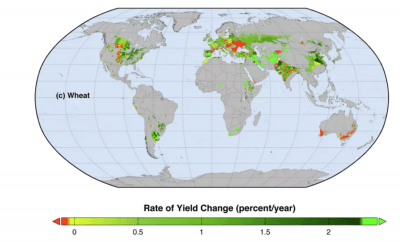Despite the attempt to increase the productivity of crops through modern agricultural techniques, a recent study found that crop yield has not been rising at a sufficient pace to meet the projected demand by 2050. The study analyzes the historical improvements in crop yields for corn, rice, wheat and soybeans. The solid lines in the graph below show that growth has been growing at a consistent rate over that past few years. However, they also show what would happen if this growth rate continues, which is a rate that is unsustainable. The dashed lines show how productivity would need to grow even more rapidly in order to satisfy the expected demand in 2050, essentially doubling global food production.
This additional wheat production graph below shows that crop productivity is not the same across the world and is actually stagnating. In the U.S. Midwest, wheat yields per acre have been rising at a 2 percent per year. But in parts of India or Eastern Europe, they’ve basically flat-lined. It is assumed that the countries experiencing this are simply not using their resources such as fertilizers properly. However, on the other hand, some parts of the world are hitting a “biological wall,” a limit on how much yields can keep rising. Even with genetic modification and better technology, there are physiological limits for plants. This in combination with the effects of global warming such as extreme heat waves that can affect crop yield are quite terrifying when considering our future. The current population of about 7 billion is projected to rise to 9.6 billion in 2050 suggesting that our crop yields will not be sustainable. Essentially, we are not growing enough to feed the world.



